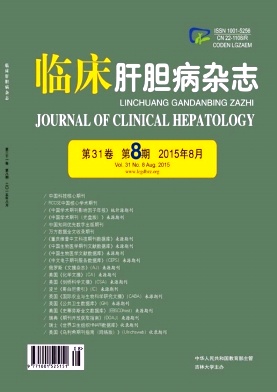| [1] | Xin SHI, Chongxiao LIANG, Bei ZHANG, Jiping WANG. Value of internal stratification analysis of abdominal wall muscles in predicting complications after orthotopic liver transplantation[J]. Journal of Clinical Hepatology, 2025, 41(2): 314-321. doi: 10.12449/JCH250218 |
| [2] | Mingqiang ZHU, Dashuai YANG, Junpeng PEI, Xiangyun XIONG, Yang SU, Youming DING. Analysis of influencing factors on biliary complications after orthotopic liver transplantation[J]. Journal of Clinical Hepatology, 2023, 39(7): 1627-1632. doi: 10.3969/j.issn.1001-5256.2023.07.017 |
| [3] | Xing DAI, Ben GAO, Xinxin ZHANG, Yanyan SUN, Wentao JIANG, Jiang LI. Establishment and validation of a risk prediction model for early-stage complications after liver transplantation[J]. Journal of Clinical Hepatology, 2022, 38(2): 402-408. doi: 10.3969/j.issn.1001-5256.2022.02.027 |
| [4] | Rongjuan SUN, Jianghua ZHAN. Research advances in the diagnostic methods for biliary atresia[J]. Journal of Clinical Hepatology, 2022, 38(7): 1681-1685. doi: 10.3969/j.issn.1001-5256.2022.07.043 |
| [5] | Nengli WANG, Xinbao XIE. Liver transplantation for pediatric acute liver failure[J]. Journal of Clinical Hepatology, 2022, 38(2): 278-281. doi: 10.3969/j.issn.1001-5256.2022.02.006 |
| [6] | Bo HE, Xin WANG, Feng WANG, Yandong SUN, Qingguo XU, Ge GUAN, Yunjin ZANG. Influence of arterial variation and reconstruction of the donor hepatic artery in liver transplantation on early postoperative arterial complications[J]. Journal of Clinical Hepatology, 2021, 37(8): 1901-1904. doi: 10.3969/j.issn.1001-5256.2021.08.030 |
| [7] | Perioperative Management Group, Chinese Society of Organ Transplantation, Chinese Medical Association. Expert consensus on perioperative vascular complications for liver transplantation(2021)[J]. Journal of Clinical Hepatology, 2021, 37(9): 2054-2057. doi: 10.3969/j.issn.1001-5256.2021.09.010 |
| [8] | Chen WeiTing, Li ShuangJie. Clinical value of transient elastography,aspartate aminotransferase-to-platelet ratio index,and fibrosis-4 in the diagnosis of liver fibrosis in children with biliary atresia[J]. Journal of Clinical Hepatology, 2020, 36(3): 546-550. doi: 10.3969/j.issn.1001-5256.2020.03.015 |
| [9] | Wang Kai, Gao Wei. Research advances in immune tolerance in children receiving liver transplantation[J]. Journal of Clinical Hepatology, 2019, 35(11): 2402-2407. doi: 10.3969/j.issn.1001-5256.2019.11.005 |
| [10] | Liu YiHe, Zheng Hong, Shen ZhongYang. Tasks and strategies for the prevention and treatment of middle-and long-term complications after liver transplantation[J]. Journal of Clinical Hepatology, 2019, 35(11): 2386-2390. doi: 10.3969/j.issn.1001-5256.2019.11.002 |
| [11] | Lu YeFeng, Xia Qiang, Qiu BiJun, Feng MingXuan, Wan Ping. An analysis of related issues in long-term survival in children after liver transplantation[J]. Journal of Clinical Hepatology, 2019, 35(11): 2396-2401. doi: 10.3969/j.issn.1001-5256.2019.11.004 |
| [12] | Section of Hepatobiliary Surgery, Branch of Pediatric Surgery, Chinese Medical Association, Section of Pediatric Hepatic Transplantation, Branch of Organ Transplantation, Chinese Medical Doctor Association. Guidelines for diagnosing & treating biliary atresia (2018 Edition)[J]. Journal of Clinical Hepatology, 2019, 35(11): 2435-2440. doi: 10.3969/j.issn.1001-5256.2019.11.009 |
| [13] | Xu Hui, Li Bing. Research advances in endoscopic treatment of biliary complications after liver transplantation[J]. Journal of Clinical Hepatology, 2018, 34(10): 2245-2250. doi: 10.3969/j.issn.1001-5256.2018.10.041 |
| [14] | Jie EnBo, Xuan FengHui, Sun XiaoDong, Sun DaWei, Lu: GuoYue. An analysis of risk factors for early complications after liver transplantation[J]. Journal of Clinical Hepatology, 2018, 34(6): 1282-1288. doi: 10.3969/j.issn.1001-5256.2018.06.030 |
| [15] | Wang MingYue, Lu ZhiYan. Imaging evaluation of complications after liver transplantation[J]. Journal of Clinical Hepatology, 2016, 32(12): 2295-2299. doi: 10.3969/j.issn.1001-5256.2016.12.013 |
| [16] | Lu: GuoYue. Risk factors for biliary complications after liver transplantation from donation after cardiac death[J]. Journal of Clinical Hepatology, 2015, 31(12): 2027-2030. doi: 10.3969/j.issn.1001-5256.2015.12.009 |
| [17] | Guo Jing, Xu LingFen, Sun Mei. Differential diagnosis of biliary atresia and intrahepatic cholestasis in children[J]. Journal of Clinical Hepatology, 2015, 31(8): 1252-1256. doi: 10.3969/j.issn.1001-5256.2015.08.017 |
| [18] | Li JiangBin, Du XiLin, Dong Rui, Yin JiKai, Lu JianGuo. Incidence and prevention of liver transplantation- related cardiovascular complications[J]. Journal of Clinical Hepatology, 2014, 30(1): 75-77. doi: 10.3969/j.issn.1001-5256.2014.01.022 |
| [19] | Hua XiangWei, Xia Qiang, Zhang JianJun, Li QiGen, Xu Ning, Chen XiaoSong, Zhang Ming, Xue Feng, Han LongZhi, Wang Xin, Xia Lei, Luo Yi, Shen CongHuan, Xing TianYu, Xi ZhiFeng. Prognos is of living donor liver transplantation performed during different periods in infants with biliary atresia: a single- center experience with 101 cases[J]. Journal of Clinical Hepatology, 2014, 30(1): 18-22. doi: 10.3969/j.issn.1001-5256.2014.01.006 |
| [20] | Shen ZhongYang. Diagnosis and management of ischemic-type biliary lesion after liver transplantation[J]. Journal of Clinical Hepatology, 2010, 26(4): 368-370. |














 DownLoad:
DownLoad: